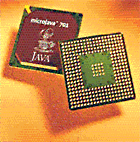The microJava 701 chip
October 15, 1997 - Sun introduced at the Microprocessor Forum (San Jose, CA) its first Java chips in the microJava series, the microJava 701.
Sun expects to be in volume production with the microJava 701 by the second half of 1998. Click here to go back to our Java chips review

Benchmarks
"Sun's internal preliminary benchmark results indicate that the microJava 701 should deliver 13,332 embedded Caffeinemarks 3.0 and 200 Dhrystone MIPS on C programs as measured by the Dhrystone 2.1 MIPS benchmark.". The combines the scores of the non-graphical tests into an overall score. The Embedded CaffeineMark is available as a from Pendragon Software.
We wanted to compare the performance of a Pentium 166 with those preliminary benchmarks. Using the Microsoft Virtual Machine (SDK 2.0) under Windows NT4 with 64Mo:
Sieve score = 1792 (98)
Loop score = 5485 (2017)
Logic score = 6963 (0)
String score = 2439 (708)
Float score = 2906 (185)
Method score = 3167 (166650)
Overall score = 3396
This means that the microJava 701 should run four times faster than a Pentium 166.
Design Overview
The microJava 701 microprocessor is being designed to suit a range of Java applications in the enterprise, communications and consumer markets. It uses the picoJava 2.0 core. The following specs come from Sun.
The memory and I/O buses have been integrated on the chips. The memory controller will support a wide range of memory: SRAM, ROM and Flash memory. The PCI controller will be compliant with the 2.1 interface standard. It will contain both an Integer and Floating-point unit as well as 16KB instruction and 16KB data caches, with a six stage pipeline and extensive instruction folding. This instruction folding allows up to four instructions to be combined for execution in a single clock cycle. The microJava 701 will be manufactured in a 0.25 micron CMOS process and has a target frequency of 200 MHz.
The design is targeted to be fully static and use a 2.5 volt core and 3.3 volt I/O supply. At a 200Mhz core frequency, the power dissipation shoud be 4W. Overall transistor count is estimated at 2.8 million.
For further information, read the press release from Sun.
Conclusion
Java code running directly on Java processors delivers an end-to-end Java solution that is applicable in multiple markets.The performance announced in those preliminary benchmarks is quite impressive. The microJava 701 microprocessor is being designed to suit a range of Java applications in the enterprise, communications and consumer markets. This should be a great success.
This page was last updated 06 March 1998